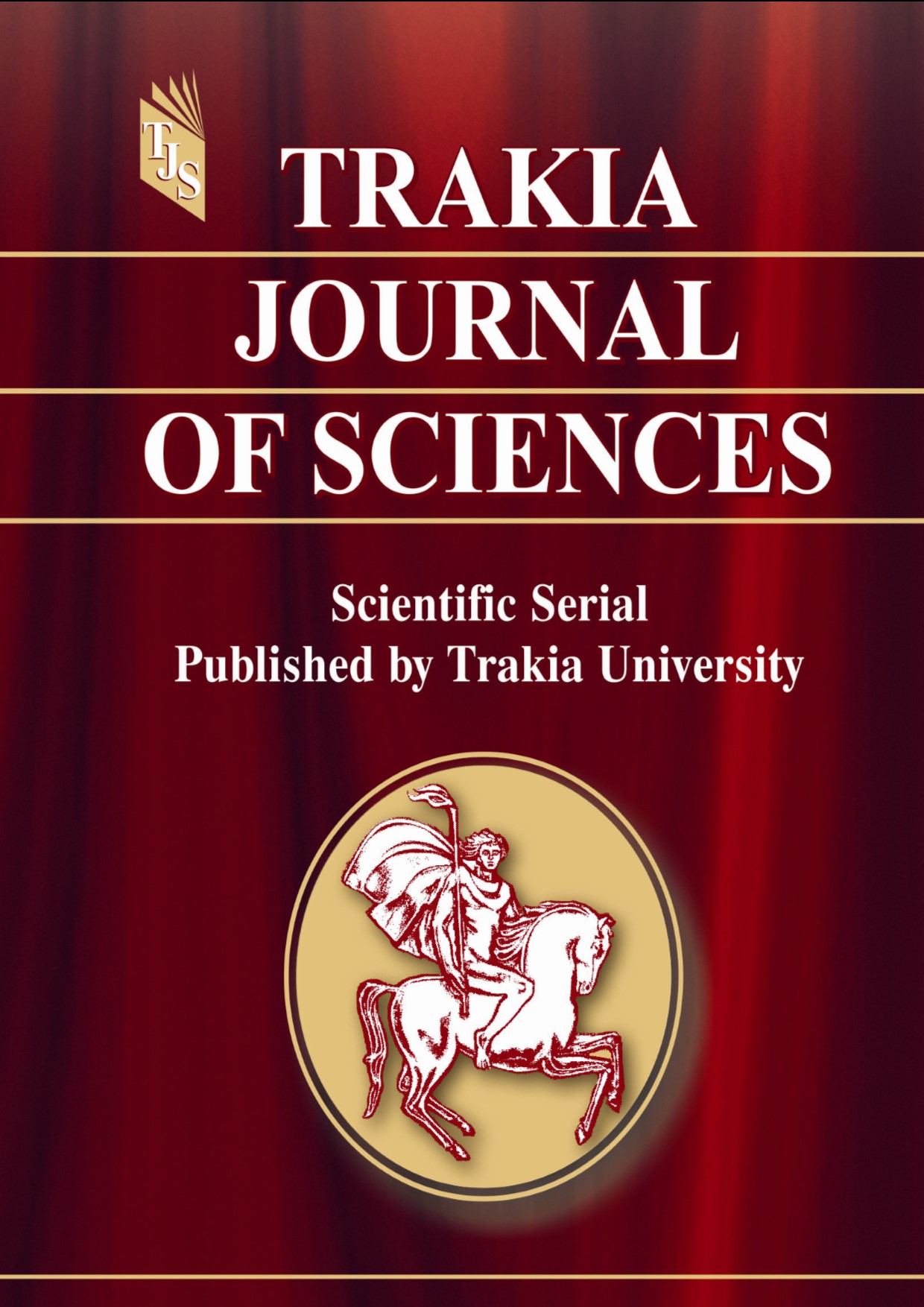INFLUENCE OF GENDER AND AGE ON CONSUMER ATTITUDES TOWARDS ADVERTISING
DOI:
https://doi.org/10.15547/tjs.2024.2.25Keywords:
differences in consumer attitudes, advertising influenceAbstract
The purpose of this article is to investigate and establish the influence of gender and age on the attitudes of young consumers of advertising. To achieve this goal, an empirical study was conducted with a contingent of 474 young respondents, whose advertising needs were analysed in three Bulgarian universities. The research data confirm, albeit partially, the presence of an influence of gender on the cognitive and affective attitudes of young consumers, with affect placed above cognition. When measuring the age differences, also by means of analysis of variance (ANOVA), a strong influence was found on the sample age group - young people aged 21 to 24 years, in which cognitive attitudes have the strongest manifestation compared to all others. Linear correlations between attitude types indicated that stronger affective attitudes evoked stronger cognitive and conative attitudes in youth. The obtained scientific results can serve specialists in the psychology of advertising, behavioural psychology and some business organizations in Bulgaria.
References
Fabrigar, R., MacDonald, K. and Wegener, T., The structure of attitudes. In The Handbook of Attitudes, ed. D Albarracin, BT Johnson, MP Zanna, pp. 79–124. Mahwah, NJ: Erlbaum, 2005.
Gawronski, B. and Bodenhausen, V., Associative and propositional processes in evaluation: an integrative review of implicit and explicit attitude change. Psychological Bulletin, 132:692–731, 2006.
Gibson, B., Can evaluative conditioning change attitudes toward mature brands? New evidence from the Implicit Association Test. Journal of Consumer Researches, 35:178–88, 2008.
Brug, J., Oenema, A. and Campbell, M., Past, present, and future of computer-tailored nutrition education. American Journal of Clinical Nutrition, 77:1028–1034, 2003.
Holland, W., Meertens, M. and Van Vugt, M., Dissonance on the road: self-esteem as a moderator of internal and external self- justification strategies. Personality and Social Psychology Bulletin, 28(12):1713–24, 2002.
Petty, E., Tormala, Z. and Rucker, D., Resisting persuasion by counterarguing: An attitude strength perspective. An Overview. In: Jost JT, Banaji MR and Prentice DA (eds) Perspectivism in social psychology: The yin and yang of scientific progress, Washington, D.C.: American Psychological Association, pp. 37-51, 2004.
Bargh, A., The psychology of the mere. An Overview. In: Bargh JA, Apsley DK (eds.) Unraveling the complexities of social life: A Festschrift in honor of Robert B. Zajonc, Washington, DC: American Psychological Association, pp. 25-37, 2001.
Lee, A., The mere exposure effect: an uncertainty reduction explanation revisited. Personality and Social Psychology Bulletin, 27:1255– 66, 2001.
Winkielman, P. and Cacioppo, J., Mind at ease puts a smile on the face: psychophysiological evidence that processing facilitation elicits positive affect. Journal of Personality and Social Psychology, 81(6):989-1000, 2004.
Crano, W. and Prislin, R., Attitudes and Persuasion, Annual Review of Psychology, 57(1):345–74, 2006.
Cacioppo, J., Marshall-Goodell, B., Tassinary, L. and Petty R., Rudimentary determinants of attitudes: classical condition is more effec- tive when prior knowledge about the attitude stimulus is low than high. Journal of Experimental Social Psychology, 28:207–33, 1992.
Courbet, D., L’influence publicitaire en l’absence de souvenir des messages: les ef- fets implicites de la simple exposition aux marques. Cahiers Internationaux de Psychologie Sociale, 57:39–51, 2003.
Till, B. and Priluck, R., Stimulus generalization in classical conditioning: an initial in- vestigation and extension. Psychology and Marketing, 17(1):55–72, 2000.
Walther, E., Guilty by mere association: evaluative conditioning and the spreading at- titude effect. Journal of Personality and Social Psychology, 82(6): 919–34, 2002.
Edwards, K., The interplay of affect and cognition in attitude formation and change. Journal of Personality and Social Psychology, 59(2):202–216, 1990.
Petty, R. and Cacioppo, J., Communication and Persuasion: Central and Peripheral Routes to Attitude Change, Springer-Verlag, New York, NY, 1986.
Chaiken, S., Heuristic versus systematic information processing and the use of source versus message cues in persuasion. Journal of Personality and Social Psychology, 39(5): 752-766, 1980.
Chaiken, S., The heuristic model of persuasion. An Overview. In: Zanna MP, Olson JM and Herman CP (eds) Social Influence: The Ontario Symposium (5), pp. 3-39. Hillsdale, NJ: Erlbaum, 1987.
Wegener, D. and Carlston D., Cognitive processes in attitude formation and change. An Overview. In: Albarracın D, Johnson, B. and Zanna, M., (eds) Lawrence Erlbaum Associatiates, pp. 493–542, 2005.
Spasova, L., Impact of gender and age on susceptibility to persuasion principles in advertisement. Economics and Sociology, 15(3): 99-117, 2022.
Fazio, H., Jackson, R., Dunton, C., and Williams, J., Variability in automatic activation as an unobtrusive measure of racial attitudes: a bona fide pipeline? Journal of Personality and Social Psychology, 69 (6):1013–1027, 1995.
Fazio, H., Attitudes as object-evaluation associations of varying strength. Social Cognition, 25 (2): 603–637, 2007.
Petty, R., Brinol, P. and DeMarree, K., The Meta-Cognitive Model (MCM) of attitudes: implications for attitude measurement, change, and strength. Social Cognition, 25. pp. 657-687, 2007.
Schwarz, N., and Clore, G. (2007). Feelings and Phenomenal Experiences. In Social Psychology: Handbook of basic principles, ed. AW Kruglanski, ET Higgins, pp. 385–407. New York: Guilford. 2nd ed., 2007.
Gawronski, B., and Bodenhausen, G., Unravelling the processes underlying evaluation: attitudes from the perspective of the APE model. Social Cognition, 25 (5): 687–717.
Conrey, R. and Smith, E., Attitude representation: attitudes as patterns in a distributed, connectionist representational system. Social Cognition, 25(5):718–35, 2007.
Eagly, H. and Chaiken, S., The advantages of an inclusive definition of attitude. Social Cognition, 25 (5): 582–602, 2007.
Cunningham, A., Zelazo, P., Packer, J. and Bavel, J. V., The Iterative Reprocessing Model: A Multileve Framework for Attitudes and Evaluation. Social Cognition, 25 (5), pp. 736-760, 2007.
DeVellis, R., Scale development: Theory and application. (3rd ed.) SAGE Publications, 2012.
Ganeva, Z., Let's reinvent statistics with IBM SPSS Statistics, Elestra, ISBN 978-619- 7292-01-5, 2016.
Cervellon, M-C. and Dube, L., Assessing the cross-cultural applicability of affective and cognitive components of attitude. Journal of Cross-Cultural Psychology, 33(3):346–357, 2002.
Huskinson, T. and Haddock, G., Individual differences in attitude structure: variance in the chronic reliance on affective and cognitive information. Journal of Experimental Social Psychology, 40(1):82– 90, 2004.
Giner-Sorolla, R., Affective attitudes are not always faster: the moderating level of extremity. Personality and Social Psychology Bulletin, 27(6): 666–77, 2001.
Giner-Sorolla, R., Is affective material in attitudes more accessible than cognitive ma- terial? The moderating role of attitude basis. European Journal of Social Psychology, 34(6):761–80, 2004.
Cohen, J., Statistical power analysis for the behavioural sciences. Lawrence Erlbaum Associates, New York, 1988.
Spasova, L. and Taneva, T., Influence of Gender on Advertising Responses of Young People for Products of Mobile Operators in Bulgaria, SISC, 2021, SHS Web of Conferences 120, 04002, 2021.
Coulter, K., The effects of affective responses to media context on advertising evaluation. Journal of Advertising, 27(4): 41-50, 1998.
Dianoux, C., Zdenek, L., Lucie, V., Attitude toward advertising in general and attitude toward a specific type of advertising – A First Empirical Approach, Journal of Competitiveness, 6 (1):87-103, 2014.

Downloads
Published
Issue
Section
License
Copyright (c) 2024 Trakia University

This work is licensed under a Creative Commons Attribution-NonCommercial-NoDerivatives 4.0 International License.


